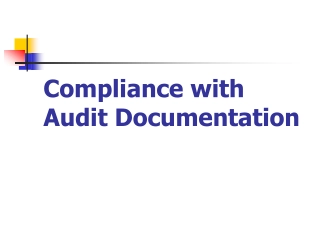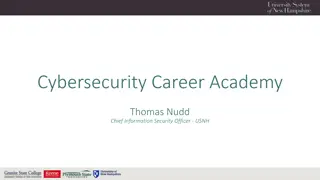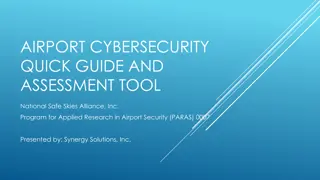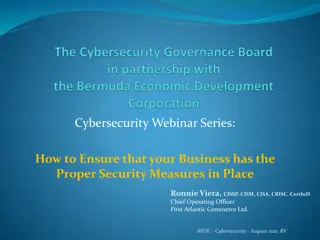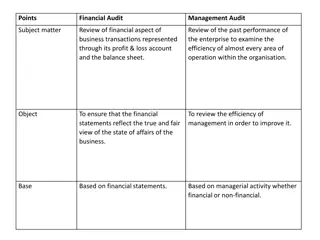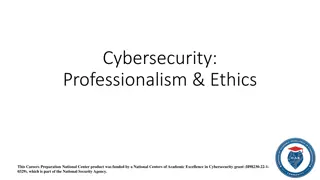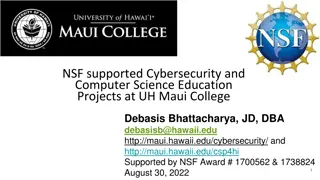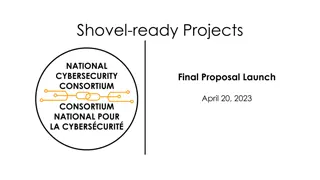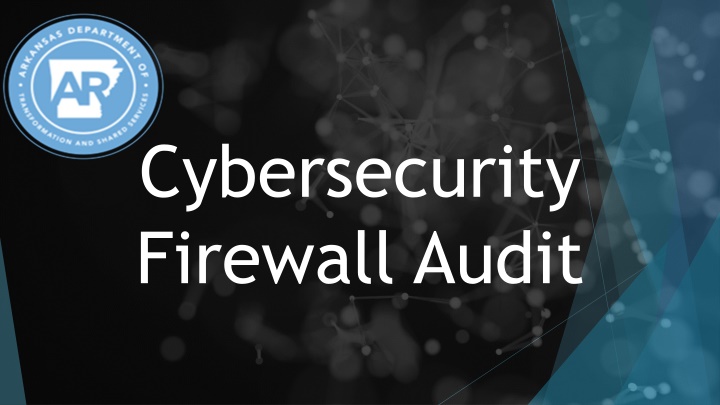
Cybersecurity Firewall Audits
Discover the significance of firewall audits in cybersecurity, including what firewalls are, why audits are crucial, and who manages state firewalls. Learn about the process of firewall audits, their importance in identifying vulnerabilities, weaknesses, and potential threats, and how they help organizations enhance their security posture and meet compliance standards.
Download Presentation

Please find below an Image/Link to download the presentation.
The content on the website is provided AS IS for your information and personal use only. It may not be sold, licensed, or shared on other websites without obtaining consent from the author. If you encounter any issues during the download, it is possible that the publisher has removed the file from their server.
You are allowed to download the files provided on this website for personal or commercial use, subject to the condition that they are used lawfully. All files are the property of their respective owners.
The content on the website is provided AS IS for your information and personal use only. It may not be sold, licensed, or shared on other websites without obtaining consent from the author.
E N D
Presentation Transcript
Cybersecurity Firewall Audit
AGENDA I N T R OD UC T I ON W H AT I S A F I R EWA LL? W H AT I S A F I R EWA LL A UD I T ? W H Y A R E F I R EWA LL A UD I T S I M P ORTA N T ? W H O M A N A G ES T H E STAT E F I R EWA LL? Transformation and Shared Services, Division of Information Systems 6 ST EP S OF F I R EWA LL A UD I T EX A M P LE: F I R EWA LL OB J EC T 1 TO 1 N AT DIS Call Center F I N A L T I P S & TA KEAWAYS (501)-682-4357 Option 3, and toll-free 800-435-7989 Option 3
4 IMPORTANT QUESTIONS ABOUT YOUR NETWORK ? ? ? ?
WHAT? WHY? WHO? WHAT IS A FIREWALL AUDIT? WHAT IS A FIREWALL? WHY ARE FIREWALL AUDITS IMPORTANT? WHO MANAGES THE STATE FIREWALL?
What Is A Firewall? A networking device that manages connections between different internal or external networks Can accept or reject connections or even filter them based on rules Firewalls work on the network and transport layer so 3 and 4 of the OSI model however there are some firewalls that can operate on the application layer or layer 7 of the OSI model and these are considered smarter they're known as next generation firewalls *Please don't confuse the application layer about the next gen firewall with a web application firewall it's not the same thing
What Is A Firewall Audit? Is a process of investigating the existing aspects of a firewall Consist of access and connection along with the identification of vulnerabilities and reports on any changes. The goal is to identify vulnerabilities, weaknesses, and potential threats. Firewall audits can help organizations detect security gaps and weaknesses, and recommend improvements to mitigate security risks
Why Are Firewall Audits Important? So why are audits important with all the compliant standards being used? Firewall audits are a way to prove to regulators or business partners that an organization's network is secure, some of these standard other than firewall audits being required they're simply best practice if you audit a firewall you're likely to catch a weakness or openness within your network and security posture this way you can adapt your policies to fit this doing due diligence is important in cybersecurity in reviewing controls and policies will be one piece that helps protect an organization if there might be the unfortunate circumstance of a lawsuit breach or some sort of regulatory issue that may come up auditing a firewall will ensure that your configuration in rules adhere to internal cybersecurity policies. A firewall audit can help improve performance by fixing the optimization of the firewall rule base.
WHO MANAGES THE STATE FIREWALL DIS SECURITY & DIS FIREWALL TEAMS dis.security@arkansas.gov dis.firewall@arkansas.gov Transformation and Shared Services, Division of Information Systems
6 STEPS OF A FIREWALL AUDIT
1. COLLECT KEY INFORMATION Prior to the audit there needs to be information gathered during this time. There needs to be visibility into the network with software hardware policies and risks To plan the audit, you need the following key information: Copies of the relevant security policies Firewall logs that can be compared to the firewall rule base to find which rules are being used Updated copy of the network and the firewall topology diagrams Any previous audit documentation including the rules objects and policy revisions Vendor firewall information including the os version latest patches and the default configuration Finally understanding all the critical servers and repositories within the network
2. ACCESS THE CHANGE MANAGEMENT PROCESS Gathered public and private ip s. Gathered vendor, hardware & software requirements for firewall changes Assign static private ip to the network device Open Incident with DIS Call Center Email firewall request to APSCNLAN field support person. Firewall changes are submitted to DIS Security & DIS Firewall New firewall objects, allow rules and policies are created Access Control List (ACL) Firewall changes are peer reviewed before being applied Change orders are implemented to ASA / Firewall Firewall changes are tested and verified by DIS Security The Local tech should verify device and connectivity and test allowed ports from LAN to outside State Network. Verification that change have been tested and implemented correctly Update copy of the network documentation of LAN changes
3. AUDIT THE ACCESS & PHYSICAL LOCATION Vendor operating system, firmware, patches and updates are extremely important, and it should be verified that these updated and applied. Firewall audits don't just involve the rule-based policies but the actual firewall itself It's important to ensure that the firewall has both physical and software security feature verifications this involves the hardware and OS software of the firewall it's important that there's a physical security protecting the firewall and management servers with controlled access this ensures that only authorized personnel are permitted to access the firewall server rooms Remove default passwords The operating system should also be audited to ensure that it passes common hardening checklist The device administration procedures should also be reviewed
4. DECLUTTER AND IMPROVE THE RULE BASE Fix any issues that are over permissive and analyze the actual policy against Firewall log Analyze VPN parameters in order to uncover users and groups that are unused / unattached / expired /for those that are about to expire To ensure that the firewall performs at peak performance the rule base should be decluttered and optimized this also makes the auditing process easier and will remove the unnecessary overhead to do this start by: Deleting the rules that aren't useful and disable expired and unused rules and objects Delete the unused connections and this includes source destination and service routes that aren't in use Find the similar rules in consolidate them into one role identify Enforce object naming conventions Evaluate the order of firewall rules for effectiveness and performance. Finally keep a record of rules objects and policy revisions for future reference
5. PERFORM A RISK ASSESSMENT AND FIX ISSUES Identify any risky rules by prioritizing by severity A thorough and comprehensive risk assessment will help identify any risky rules that ensure the rules are compliant with internal policies and relevant standards and regulations this is done by prioritizing the rules by severity and based on industry standards and best practices this is based upon district needs in risk acceptance of the organization things to look for check to see if there are any rules or go against and violate your district security policy. Do any of the firewall rules use any in the source destination service protocol application or use fields with a permissive action. Do any of the rules allow risky services to your internal network (LAN). What about any rules that allow risky services from the Internet coming inbound to sensitive servers, networks devices and databases. DATA Rules that use ANY Rules that allow risky inbound services There should be an action plan for remediation of these risks in compliance exceptions that are identified and the risk analysis it should be verified that the remediation efforts have taken place in any rule changes have been completed correctly *These changes should be tracked and documented
6. CONDUCT ONGOING AUDITS If you have questions or need immediate assistance, please call in an incident to the DIS Call Center and contact your APSCNLAN Field Support Person. DIS Call Center Now that the initial audit is done, we need to continue auditing to ensure that this is an ongoing process to ensure that there is a process that is established in continuous for future firewall audits to secure the district network, but also the State Of Arkansas network, other state identities and data & resources on the state network. All procedures need to be documented to complete an audit trail (501)-682-4357 Option 3, and toll-free 800-435-7989 Option 3
EXAMPLE: FIREWALL OBJECT 1 TO 1 NAT *If you need assistance with Private / Public IP s - Contact APSCNLAN Field Support Example: 1 to 1 NAT (Add / Remove) object network SECURITY_CAMERA_HS_Public host 165.29.x.x object network SECURITY_CAMERA_HS_Private host 10.X.X.X VENDOR DEVICE OBJECT DESCRIPTION SECU_CAM_HS VOIP_SERVER DISTRICT_WEB Private IP Public IP Ports TCP,UDP 123 TCP 443 TCP,UDP 80, www 9100 TCP Company 1 IP Camera Company 2 Software 1 Software 2 10.10.10.10 165.29.x.x 10.10.10.20 165.29.x.x 10.10.10.30 170.211.x.x 10.10.10.40 170.211.x.x Phone Server Web Server Efinance Printer OPTIO_PRINTER
COLLECT KEY INFORMATION ACCESS THE CHANGE MANAGEMENT PROCESS FINAL TIPS & TAKEAWAYS AUDIT THE ACCESS & PHYSICAL LOCATION DECLUTTER AND IMPROVE THE RULE BASE PERFORM A RISK ASSESSMENT AND FIX ISSUES CONDUCT ONGOING AUDITS
THANK YOU Christopher Dodds christopher.dodds@arkansas.gov APSCN LAN Support Field Support Transformation and Shared Services, Division of Information Systems o. 501.251.5057 | christopher.dodds@arkansas.gov Website | Facebook | Twitter | LinkedIn | Instagram www.apscnlan.k12.ar.us https://www.transform.ar.gov/information-systems/support/dis-field-support/

